For Course Creators, Coaches, Consultants, and Digital Product Sellers
To jump to the 8 alternatives, go here.
–

Takeaways
- 8 proven alternatives to social media marketing that actually work
- Why focusing on ONE method for 90 days beats spreading yourself thin
- SEO compounds over time while social media posts disappear in 24 hours
- Speaking at one event can generate more leads than months of posting
Your Action Plan:
- Choose ONE alternative that matches your business type and strengths
- Follow the 90-day deep focus implementation timeline
- Use the provided checklists to avoid missing critical steps
Marketing without social media is possible. Many course creators, coaches, and digital product sellers are doing it successfully.
You don’t need to spend hours posting on social platforms. Instead, you can build real connections and get better leads.
In this guide, I’ll show you 8 proven ways to market your business without social media. You’ll discover how to pick the best methods and make them work for you.
8 Alternatives to Social Media Marketing
Alternative | Best for Business Type | Primary Benefit | Implementation Focus |
|---|---|---|---|
Email Marketing | All types | Highest ROI and direct communication | List building and automation |
SEO | Course Creators | Long-term organic traffic | Content creation and keyword targeting |
Speaking/Podcasting | Coaches/Consultants | Authority building and credibility | Media kit and systematic outreach |
Partnership Marketing | All types | Audience leverage and shared credibility | Relationship building and joint ventures |
Direct Outreach | Coaches/Consultants | Personal relationships and trust | Personalized networking and follow-up |
Content Marketing | All types | Thought leadership and expertise | Guest publishing and valuable content |
Referral Systems | All types | Sustainable word-of-mouth growth | Customer satisfaction and incentive programs |
Paid Advertising | All types | Scalable and predictable leads | Budget management and conversion optimization |
Each alternative offers unique advantages. You can combine them strategically for maximum impact.
Alternative #1: Email Marketing (Highest ROI Channel)
Email marketing returns $36 for every $1 spent (source).
Email gives you a direct line to your audience without algorithm interference. No platform can decide whether your message gets delivered or buried in a feed somewhere. You own the relationship completely.
The ROI speaks for itself across all business types. Your audience data belongs to you, not some tech giant who might change the rules tomorrow and suspend your account. Email automation workflows designed specifically for solopreneurs make the process scalable without burning you out.
Email Marketing Strategy by Business Type
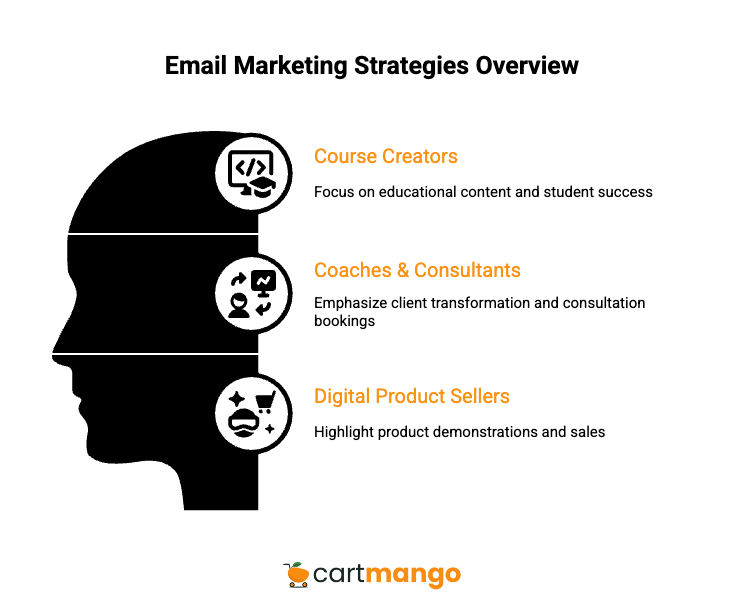
Business Type | Lead Magnets | Email Sequences | Primary Focus | Success Metrics |
|---|---|---|---|---|
Course Creators | Free mini-courses, resource guides, educational templates | Educational content demonstrating teaching expertise | Course enrollment and student success stories | Email subscribers, course completions |
Coaches & Consultants | Assessment tools, strategy frameworks, diagnostic checklists | Case studies and client transformation stories | Consultation bookings and service inquiries | Consultation bookings, client testimonials |
Digital Product Sellers | Free templates, lite versions, step-by-step tutorials | Product demonstrations and practical use cases | Product sales and affiliate partnerships | Product downloads, affiliate signups |
Email Marketing Checklist
Setup Phase:
- Choose email platform (BirdSend or Mailchimp)
- Create lead magnet relevant to your business type
- Set up opt-in forms on your website
- Write welcome email series (3-5 emails)
Content Creation:
- Write welcome email for Day 1
- Create follow-up emails for Days 3, 5, 7
- Plan monthly newsletter content calendar
- Develop email templates for promotions
- Set up automated sequences for different subscriber actions
Optimization:
- Test subject lines for better open rates
- Segment your list by subscriber behavior
- Track click-through rates and conversions
- Clean your email list quarterly
- A/B test different email formats
Alternative #2: Search Engine Optimization (SEO) – Long-Term Traffic Generation
70% of marketers agreed SEO is more effective at getting sales than PPC (source).
Perhaps the most overlooked aspect of SEO is how it compounds over time. While social media posts disappear into the void after 24 hours, your blog content keeps working for months or years. People actively searching for solutions have much higher intent than casual social media scrollers.
Your content works continuously to generate leads. Even while you’re sleeping or taking a vacation, Google sends qualified prospects to your website. SEO optimization techniques specifically for educational and service-based content focus on long-tail keywords that convert better than broad terms.
SEO Strategy by Business Type
Course Creators should target keywords like “how to learn [topic]”, “[skill] for beginners”, and “best [topic] training”. Your content types include tutorial blog posts, skill-building guides, and student success stories. These pieces demonstrate your teaching ability while providing value upfront.
Coaches & Consultants benefit from keywords such as “[problem] solution”, “[industry] consulting”, and “how to [achieve specific goal]”. Case studies, strategy frameworks, and client result stories position you as the expert who gets results.
Digital Product Sellers can focus on “[tool] template”, “free [resource type]”, and “[problem] solution toolkit”. Product tutorials, comparison guides, and practical use case examples show prospects exactly how your products solve their problems.
SEO Tools
WordPress with Yoast SEO plugin handles technical optimization. Google Analytics 4 tracks performance and conversion measurement. Moz’s comprehensive SEO guide walks you through SEO step by step.
Ubersuggest and AnswerThePublic provide keyword research and content ideas. These free tools reveal what your audience actually searches for.
SEO Checklist
Technical Setup:
- Install WordPress with Yoast SEO plugin
- Set up Google Search Console
- Connect Google Analytics 4
- Create XML sitemap
- Check website loading speed
Keyword Research:
- Use Ubersuggest for keyword discovery
- Research competitor keywords
- Find long-tail keywords for your niche
- Create keyword spreadsheet with search volumes
- Identify content gaps in your industry
Content Creation:
- Write blog posts targeting specific keywords
- Create tutorial content for your audience
- Optimize meta titles and descriptions
- Add internal links between related posts
- Include relevant images with alt text
Alternative #3: Strategic Speaking & Podcasting *Authority Building)
77% of marketers say podcasts are the most effective content type for moving leads from awareness to consideration in the early buyer’s journey (source).
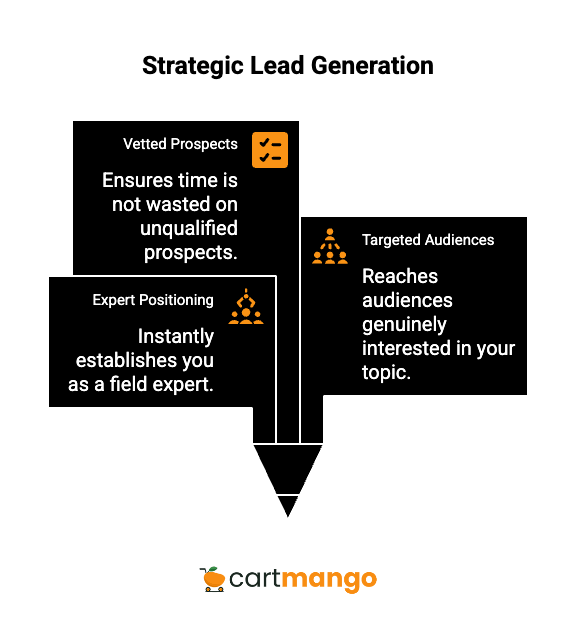
Speaking engagements can generate more qualified leads than months of social media posting. This is because it positions you as the recognized expert in your field instantly.
You reach targeted audiences already interested in your topic. Event organizers vet their audiences, so you’re not wasting time on unqualified prospects.
Speaking Strategy by Business Type
Course Creators should target educational conferences, online summits, and skill-building webinars. Your topics include teaching methodologies, industry trends, and student success strategies. These venues attract people actively seeking to learn and improve their skills.
Coaches & Consultants find success at business conferences, mastermind events, and professional association meetings. Business strategies, industry insights, and client transformation case studies resonate with these audiences. They’re looking for proven solutions to real problems.
Digital Product Sellers work well at productivity events, design conferences, and tool-focused online meetups. Efficiency strategies, design trends, and tool comparisons attract people already interested in optimization tools.
Speaking Implementation Tips
Your professional media kit needs headshots, bio, and topic summaries. This one-page document makes it easy for event organizers to say yes. Systematic outreach using templates for event organizers and podcast hosts scales your efforts.
Follow-up sequences convert speaking appearances into qualified leads. Most speakers forget this crucial step and waste their speaking opportunities.
Speaking & Podcasting Checklist
Preparation:
- Create professional media kit with bio and headshot
- Develop 3-5 signature topics you can speak about
- Practice 30-minute presentation
- Research target podcasts and events
- Prepare your speaker one-sheet
Outreach:
- Create list of 20 target podcasts
- Write personalized pitch emails
- Follow up systematically
- Track responses and bookings
- Schedule speaking engagements
Follow-up:
- Send thank you notes after appearances
- Share episode links on your website
- Collect contact information from new connections
- Convert speaking leads to email subscribers
- Ask for referrals to other shows
Alternative #4: Partnership Marketing (Leverage Other People’s Audiences)
Partnership marketing gives you immediate access to established, engaged audiences.
You’re borrowing credibility from trusted partners instead of building it from scratch. The customer acquisition costs stay lower compared to paid advertising, and you’re reaching people who already trust your partner’s recommendations.
When someone you trust recommends a product or service, you’re much more likely to buy. Partnership marketing strategies that generate sustainable revenue streams tap into this psychological principle. Your partner’s audience sees you as pre-vetted and trustworthy.
Partnership Strategy by Business Type
Course Creators can develop joint course collaborations with complementary educators in related fields. Cross-promotions with established course platforms and learning communities expand your reach quickly. Affiliate partnerships with educational tool companies and software providers create ongoing revenue streams.
Coaches & Consultants benefit from referral networks with complementary service providers who aren’t competitors. Strategic alliances with business organizations and professional associations provide credibility and access. Guest expert opportunities in other coaches’ programs and masterminds position you as the go-to expert.
Digital Product Sellers should focus on affiliate programs with productivity influencers and industry bloggers. Bundle collaborations with complementary product creators increase perceived value. Sponsorship opportunities in relevant newsletters and podcast advertisements reach targeted audiences actively seeking solutions.
Partnerships take time to develop properly. You’re building relationships, not just extracting value from other people’s audiences.
The best partnerships feel like genuine collaborations where everyone wins.
Partnership Marketing Checklist
Partner Identification:
- List 10-15 complementary businesses (not competitors)
- Research their audience and values
- Find mutual connections for warm introductions
- Prepare partnership value proposition
- Create partnership proposal template
Relationship Building:
- Reach out with collaboration ideas
- Offer value before asking for anything
- Set clear expectations and goals
- Create formal partnership agreements
- Plan joint marketing activities
Management:
- Track referrals from each partner
- Maintain regular communication
- Share results and successes
- Provide promotional materials to partners
- Schedule quarterly partnership reviews
Alternative #5: Direct Outreach & Networking (Personal Relationship Building)
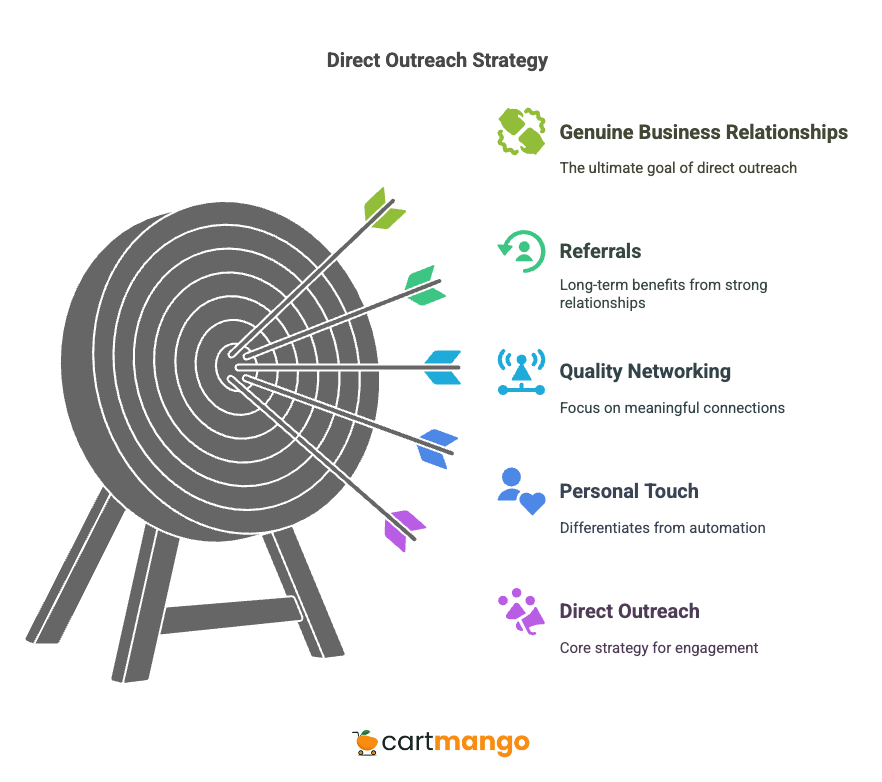
Direct outreach still works because most people hide behind automation and mass marketing. Your personal touch stands out in an increasingly robotic world. The conversion rates blow mass marketing approaches out of the water when done properly.
You’re building genuine business relationships that compound over time. One strong relationship can generate referrals for years. Networking strategies specifically designed for solopreneurs focus on quality over quantity.
Outreach Strategy by Business Type
Course Creators should use targeted outreach to potential students via industry-specific events, workshops, and offline communities. Networking at educational conferences and professional development events creates face-to-face connections. Relationship building with other educators and course platform representatives opens doors to partnership opportunities.
Coaches & Consultants excel with strategic outreach to ideal clients through industry associations and local business groups. Local business networking through chamber of commerce and professional groups builds community presence. Active participation and leadership in relevant professional associations establishes expertise and trust.
Digital Product Sellers can reach potential customers and industry influencers through direct outreach. Active networking in design and productivity-focused communities builds relationships with your target market. Potential affiliate partners and collaborators often come from these same networks.
Direct Outreach Checklist
Prospect Research:
- Identify ideal customer characteristics
- Research prospects’ recent activities and achievements
- Find contact information and verify accuracy
- Segment prospects by priority level
- Create personalized outreach messages
Outreach Execution:
- Send personalized emails (avoid generic templates)
- Follow up 2-3 times with different angles
- Track open rates and response rates
- Schedule calls with interested prospects
- Log all interactions in CRM system
Relationship Nurturing:
- Add value in every interaction
- Remember personal details from conversations
- Send relevant resources and articles
- Make introductions to other valuable contacts
- Stay in touch with long-term prospects
Alternative #6: Content Marketing & Guest Publishing (Thought Leadership)
Content marketing demonstrates expertise through valuable, actionable content.
You’re building trust and credibility before asking for any commitment. These long-term digital assets continue generating leads over time, unlike social media posts that disappear quickly.
I’ve seen single guest posts generate leads for months or even years. The key is creating content that solves real problems your audience faces. Content marketing strategies for establishing thought leadership focus on providing value first and selling second.
Content Strategy by Business Type
Course Creators should focus on guest posting for educational blogs and industry-specific publications. Contributing valuable resources to online learning communities builds reputation. Comprehensive tutorials and educational resource guides showcase your teaching ability.
Coaches & Consultants benefit from thought leadership articles in business publications and industry media. Contributing expert commentary and insights to relevant news stories positions you as the expert journalists call. Detailed case studies and strategic frameworks demonstrate your methodology and results.
Digital Product Sellers can guest post on design and productivity-focused blogs. Contributing to tool review sites and comparison communities reaches people actively researching solutions. Detailed product tutorials and practical implementation guides help prospects understand your product’s value.
Guest publishing requires consistent effort and relationship building. You’re not just submitting random pitches to websites. Build relationships with editors and consistently provide value.
Content Marketing Checklist
Content Strategy:
- Identify target publications for guest posting
- Research their content guidelines and audience
- Create content calendar with topics
- Develop expertise-based article ideas
- Plan content distribution strategy
Content Creation:
- Write valuable, actionable articles
- Include relevant internal and external links
- Add compelling author bio with clear CTA
- Format content according to publication guidelines
- Include relevant images and graphics
Promotion and Tracking:
- Share published content on your website
- Track traffic from guest posts
- Monitor mentions and backlinks
- Build relationships with editors
- Repurpose content for your own channels
Alternative #7: Referral Systems (Systematic Word-of-Mouth)
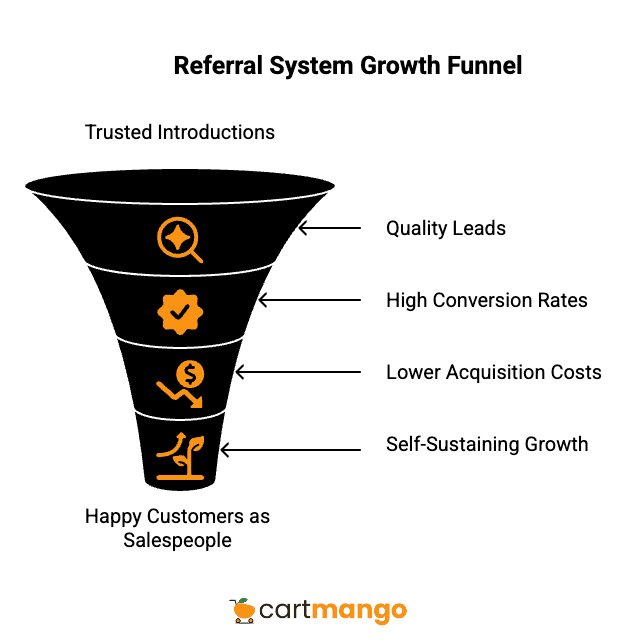
Referral systems generate quality leads through warm, trusted introductions. The conversion rates destroy cold traffic because someone the prospect trusts recommended you. Customer acquisition costs stay lower than most other marketing channels.
Once you establish proper systems, the growth becomes self-sustaining. Happy customers become your best salespeople.
Referral Strategy by Business Type
Course Creators can implement student referral programs with course discounts or bonus content incentives. Affiliate programs for successful graduates who want to promote your courses create ongoing revenue. Cross-referral partnerships with other educators in complementary subjects expand your reach.
Coaches & Consultants should offer client referral programs with service credits or fee reductions. Professional referral networks with complementary service providers create mutual benefit. Alumni networks from previous coaching programs and group sessions maintain long-term relationships.
Digital Product Sellers benefit from customer referral programs with product discounts or exclusive bonuses. Affiliate networks with complementary product creators and tool makers reach new audiences. User-generated content programs featuring customer success stories provide social proof and generate referrals.
The secret is asking for referrals systematically, not just hoping they happen naturally. Most satisfied customers will refer others if you simply ask and make it easy for them.
Referral Systems Checklist
System Setup:
- Create referral program structure
- Decide on incentives (discounts, bonuses, credits)
- Set up tracking system for referrals
- Design referral materials and links
- Create referral program landing page
Implementation:
- Train team on referral process
- Ask satisfied customers for referrals directly
- Send referral requests via email
- Make referring easy with simple process
- Follow up on referral outcomes
Optimization:
- Track referral conversion rates
- Test different incentive structures
- Gather feedback from referring customers
- Recognize and thank top referrers
- Continuously improve referral experience
Alternative #8: Paid Advertising (Non-Social) – Scalable Lead Generation
Paid advertising provides more stable and predictable results than social media advertising.
Higher intent audiences actively search for solutions instead of passively scrolling through feeds. You’re reaching people who raised their hand and said they want what you’re selling.
Paid Advertising Strategy by Business Type
Course Creators can use Google Ads targeting educational and skill-development keywords. YouTube advertising on relevant educational channels reaches engaged learners. Podcast sponsorships in education and professional development shows target motivated audiences.
Coaches & Consultants should focus Google Ads on consultation booking and business solution keywords. Targeted advertising in business publications and industry websites positions you in front of qualified prospects.
Digital Product Sellers benefit from Google Shopping ads for product visibility and comparison searches. Display advertising on relevant productivity and design websites reaches your target market. Newsletter sponsorships in productivity and business tool publications get you in front of engaged subscribers.
Why Paid Advertising Comes Last
Paid advertising works best when you have proven conversion systems from the previous 7 alternatives. Start with organic methods to understand your audience and refine your messaging. Establish conversion processes before investing in paid traffic.
You need to know what works before you scale it with advertising dollars.
Paid Advertising Checklist
Campaign Setup:
- Define target audience and demographics
- Set clear campaign objectives and KPIs
- Choose appropriate advertising platforms
- Create compelling ad copy and visuals
- Set up conversion tracking
Launch and Management:
- Start with small budget for testing
- Monitor campaign performance daily
- A/B test different ad variations
- Adjust targeting based on results
- Scale successful campaigns gradually
Optimization:
- Analyze cost per acquisition regularly
- Pause underperforming ads
- Optimize landing pages for conversions
- Track return on ad spend (ROAS)
- Document what works for future campaigns
The 90-Day Deep Focus Implementation Plan
Choose ONE Alternative Method
Spreading your efforts across multiple alternatives is a recipe for mediocre results. Successful solopreneurs focus intensively on mastering one method completely before adding others. You want depth, not breadth.
Choose your primary alternative based on your natural strengths and existing skills. Consider your available time and resources realistically. Think about your business type and target audience preferences.
Recommended Starting Points by Business Type:
- Course Creators: Email Marketing or SEO
- Coaches & Consultants: Speaking & Podcasting or Direct Outreach
- Digital Product Sellers: Email Marketing or Content Marketing
Implementation Timeline
Timeline | Phase | Key Activities | Success Indicators |
|---|---|---|---|
Week 1 | Research & Planning | Study chosen method, competitor analysis, strategy creation | Clear roadmap and tool selection completed |
Weeks 2-3 | Content & Asset Creation | Develop lead magnets, create templates, build landing pages | All assets created and tested |
Week 4 | Soft Launch & Testing | Begin small-scale implementation, gather initial feedback | Systems operational, initial data collected |
Weeks 5-8 | Full Implementation | Execute method systematically, maintain consistent schedule | Momentum building, metrics improving consistently |
Weeks 9-12 | Optimization & Scaling | Refine based on data, create SOPs, automate processes | Method mastered, ready for next alternative |
Building a Successful Business Without Social Media
Many business owners feel pressured to maintain a social media presence. But if you hate social media or want to quit social media, you’re not alone. Plenty of small businesses and different businesses have found other marketing strategies that work better for them.
Running your own business means you get to choose what fits your style and goals. A new marketing strategy that doesn’t rely on social media platforms can help you attract clients in ways that feel authentic and sustainable.
Why These Marketing Tools Work Better Than Social Media
Using marketing tools like SEO, writing articles, and guest blogging can drive consistent traffic to your sales page. SEO drives potential clients to your website by focusing on relevant keywords that answer questions your audience is asking.
Creating blog articles and guest blog posts lets you share your brand voice and build a loyal following. This approach helps you form deeper connections with your audience, leading to more clients and sustainable growth.
If you prefer personal interaction, joining your local chamber or attending in person events can help you meet new clients and many clients face-to-face. These connections often lead to referrals and a wide audience.
Alternative Approaches That Actually Work
Starting your own podcast or being a podcast guest is another powerful way to reach a wide audience without social media managers or the stress of managing social media platforms. Podcasts allow you to share your story, answer questions, and showcase your expertise.
While some believe running ads or having a big following on social media is the only option, that’s not true. You can write copy that converts, run ads on other platforms, and focus on the long game to achieve your business goals.
Whether you want immediate results or prefer the long game, these strategies are your best bet for attracting new clients. You don’t need to il address every marketing channel at once – pick what works for your mental health and business goals.
Building a successful business is about finding what works for you and your specific situation as one of many business owners who’ve chosen to step away from social media platforms.
Your Turn
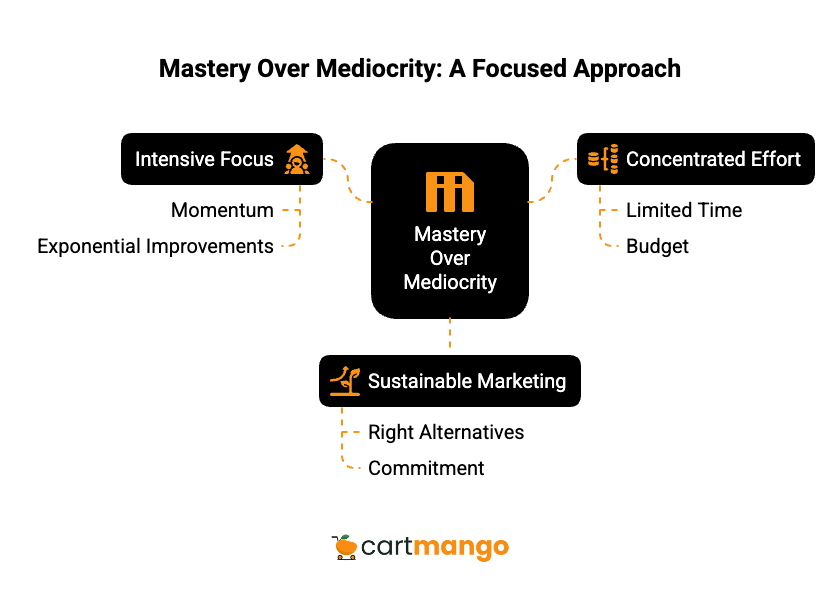
Mastery beats mediocrity every time. You get better results excelling at one method than struggling with several. The intensive focus creates momentum and exponential improvements over time.
Concentrated effort maximizes your limited time and budget. Deep implementation reveals insights you miss with surface-level approaches. One strong channel provides a stable base for future expansion.
Pick one method and stick with it for 90 days minimum.
Marketing without social media is not about avoiding platforms. It’s about focusing on what works best for your business and audience. By choosing the right alternatives and committing to them, you build a sustainable marketing system that lasts.
Related
- Gumroad vs Sellfy: The Vendor Lock-in Cage (2025)
- Gumroad vs Payhip: The Hidden Trap for Creators (2025)
- ThriveCart vs SamCart – The Subscription Hostage Trap (2025)
- 8 ThriveCart Alternatives & The Lifetime Pricing Paradox (2025)
- 8 SamCart alternatives + Subscription hostage (2025)
- The GENTLE Method: Soft marketing for creators
- How Far in Advance Should You Promote a Webinar?
- The SAVINGS Method: The Productivity Improvement Plan for Creators
- 9 Questions to Ask: How to Hire a Digital Marketing Agency
- Decision That Costs Millions? Marketing Funnel vs Customer Journey
